With cheap heroin becoming easily available in and near Darien, you can do a number of things to make it less likely that your child will become addicted to it or prescription opioid drugs similar to it, according to experts at a recent panel discussion in Darien.
Advice from members of the panel discussion, “Straight Talk-Lifting the Veil: Facing the Hidden Drug Epidemic in Darien” (which Darienite.com is combining with previously reported advice from Police Chief Duane Lovello) at seemed to fall into three categories:
- Preventing opioid prescription medications from getting into the child’s hands at home (after a doctor prescribed them either for the child or for a family member);
- Countering the influence of your child’s friends who could lead him or her into drug use;
- Taking more active steps when your suspicions are aroused.
Parents should also recognize that athletes at school also have an incentive to abuse pain medications to keep playing a sport after an injury.
__________
This article, the second in a series “Heroin in Darien” based on the “Straight Talk-Lifting the Veil: Facing the Hidden Drug Epidemic in Darien” panel discussion on Nov. 5, looks at what parents, potential addicts and others can do to prevent addiction or begin to deal with it. The first part looked at what police are confronted with in dealing with heroin and prescription painkiller abuse in Darien. Future articles this week will present information on how addiction starts, how addiction is treated and what it’s like to become addicted and to overcome it.
_________
Dr. John Douglas, clinical director of the outpatient addiction program at Silver Hill Hospital in New Canaan, said there are physical and behavioral signs that your child may have an addiction, including:
- Appearing so drowsy that “they often are nodding out. Someone is falling asleep, then waking up suddenly again.”
- “They have slurred speech.”
- Pupils of the eyes may be constricted (noticeably smaller than normal)
- They get constipated.
- Users may have needle tracks on their arms, although heroin has become so powerful that it can be smoked or snorted. Douglas noted needle tracks on arms as a sign to look for when a person in distress may be overdosing.
A drug user often tries to stop taking narcotics (and frequently fails), and there are signs for that, too, Douglas said. The withdrawal symptoms include:
- Nausea
- Vomiting
- Eyes tearing up
- Sweating
- “There’s a lot of abdominal pain”
- “A lot of muscle pain, bone pain”
- The pupils of the eyes become dilated (larger)
If someone’s already going through withdrawal symptoms, then they’re already addicted, and they need serious treatment. “This is much, much more severe than marijuana or alcohol,” Robert DiRoma Jr., a drug and mental health counselor in Darien, said of opiate addiction.
Here’s a video of the panel discussion from Darien TV79:
The Hidden Drug Epidemic – Depot 11-5-15 from Darien TV79 on Vimeo.
For children who avoid these drugs in adolescence, there’s a much better chance that as adults they won’t become addicts, said Nick deSpoelberch, an addiction and mental health counselor himself in recovery from a heroin addiction.
“Eighty-three percent of people who develop a serious addiction in their life begin serious use in adolescence,” he said. “So, in my opinion […] as a parent if you can get your kid through this time period [adolescence] without abusing substances, you greatly decrease their chances.”
Here’s the experts’ advice on how to help your child avoid opioid addiction:
(1) Keeping the pills away
There are legitimate, good uses for opioid prescription medications like oxycodone, hydrocodone and Fentanyl, Douglas said, but “they should be used on a short-term basis. These are not chronic medications. It’s not shown to be helpful on a long-term basis.”
So if you or your children are prescribed a pain medication after surgery or for some temporary medical condition, Douglas suggests you ask your doctor, “How long should I take this? [Or how long should your child take it.] Is there any risk if I take this over a week?”
In a bit less than a week, abusing opioids gives the abuser a physical dependence on them, meaning that stopping their use can cause discomfort, often severe discomfort, so preventing an addiction from forming in the first place is a much easier task than trying to break one.
“We urge you to look through your cabinets and see what’s in there, and be mindful of how many pills you actually have if you have someone who’s going along this road,” Darien Police Sgt. TJ White said.
More advice on separating these pills from your children:
- If the pills are in the house, find a way to lock them up, deSpoelberch said.
- If your son or daughter is prescribed an opioid pain medication, you be the one to give it to your child pill by pill, deSpoelberch said. Don’t leave the bottle in their hands.
- The number of pills in the bottle is printed on the label. Cross out the number and rewrite how many are left each time you dispense a pill, so there’s a record of what’s left — if pills disappear, you’ll know, deSpoelberch said.
- If the pain goes away and there are still pills in the bottle, get the pills out of your home. Rather than flushing them down the toilet (which can contribute to environmental damage in Long Island Sound) or throwing them in the trash (where somebody might find them), Whyte said you can drop them off (in the pill bottle) at Darien Police Headquarters, where there’s a box in the lobby. No questions asked. The department disposes of the pills in a safe way.
All this will help somewhat, but your kids can still get pills from elsewhere. Be more alert to the signs of opiate abuse around the time when your teenager is studying for midterms or finals, Darien Police Sgt. Jeremiah Marron suggests.
“We do notice during finals, midterms, that there is a spike in medication, transactions, illicit narcotics use,” Marron said. “We hear that kids go to study at the library […] and the librarys been dubbed ‘The Candy Shop.’ […] a trading ground for prescription ‘study drugs,’ as they call them.”
(2) Countering peer pressure
Kids who are particularly anguished about problems in life and athletes who are injured are more especially at risk to abuse opioid drugs, but Roody Joseph, DiRoma’s partner at the Counseling Center for Discovery & Change in Darien, said there’s risk for any kid who has a friend or friends who are abusing drugs.
“I think everyone’s actually susceptible, all children,” he said. “They see other kids doing it. […] Oftentimes kids are not going to say, ‘You know what, I’m not going to do this,’ especially if it’s boys. They’ll say, ‘OK, I’m not going to do this,’ but there’s a girl there. ‘I’m going to impress [her], and she’s doing it, so I’m going to do it too.'”
Opioid drugs are so widely available that kids may well encounter them, Joseph said. When he played sports in college, it was easy to get the opioid drug Percocet, and he found a player in a locker next to his snorting cocaine. “So it’s out there, it’s in our home — and that’s the scariest part,” he said.
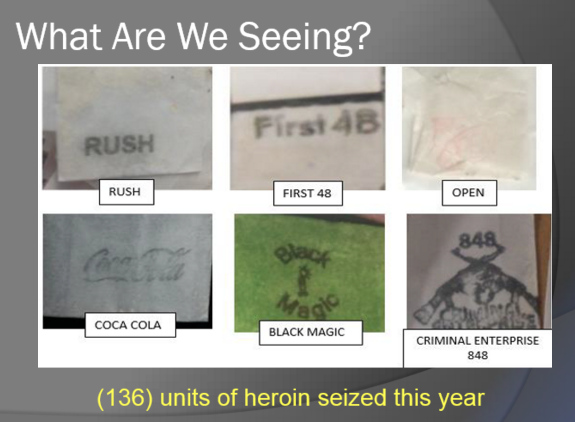
Heroin in powder form is often sold in folded wax paper with stamps like these. These examples were seized by police in the area. (from Police Sgt. TJ Whyte’s presentation)
When kids take drugs, Douglas said, “It’s usually under social pressure in a social circumstance where other people are using. That’s one of the things to look out for — is your child with other people that you know are using drugs? That’s one of the highest risk factors around — if they’re surrounded by that.
He added, “Another risk factor is if they don’t feel well-connected to their school, where they’re not doing well in school, that also places them at risk of using substances.”
It’s important that your children know they can talk to you about drug use, said Robert DiRoma Jr., Joseph’s partner at the Counseling Center for Discovery & Change. He suggests you repeatedly let them know that you’re “emotionally available” to them — that is, available to talk to them about it (and if you do, that you won’t blow up in anger or fear or otherwise make the conversation uncomfortable).
“If you just come to your children and say, ‘Listen, I’m here for you, and you continually reiterate that to them, they’re going to know that, ‘OK, it’s safe for me to talk to my mom, it’s safe for me to talk to my dad,’ and, knowing that they can do that and come to you with possibly a very, ah, I guess ‘taboo’ subject […] If they feel comfortable coming to you about that, then I’d say you’ve done your job, I guess.”
He added later: “Even if they don’t want to talk to you at first, just by you telling them on a consistent basis, not even every day, just telling them, ‘Hey, is everything OK? How are you doing? I’m here if you need to talk about anything,’ eventually they will come because eventually they’re going to say, ‘Oh, mom really means that. Dad really means that. They tell me that all the time.'”
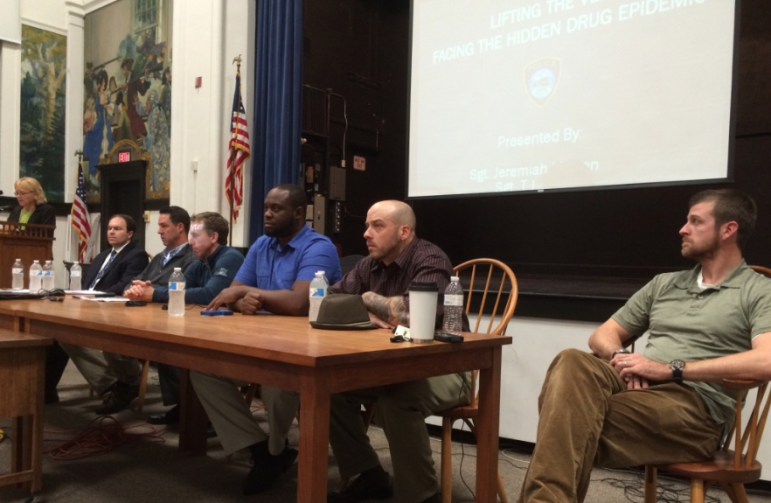
The panel discussion: From left: Standing, Ingrid Gillespie of Communities4Action; Seated: Dr. John Douglas of Silver Hill Hospital, Darien Police Sergeants Jeremiah Marron and TJ Whyte, counselors Roody Joseph and Robert DiRoma Jr., Nick Despoelberch, who spoke about his addiction and recovery.
Joseph said: “A lot of times it’s just being able to make that connection. Be able to come in and see what’s really on their minds, what’s bothering them.”
At another point, he said, “It really comes [down] to just dealing with your child, talking with your child on a daily basis, and to really understand what they’re going through on a daily basis.”
While being “emotionally available” for your child, make it clear that your expectation is that your child not use illegal drugs or alcohol, Douglas said.
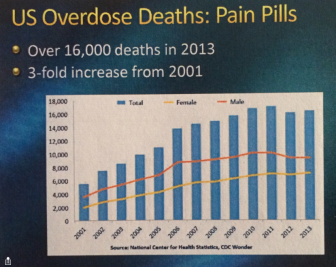
Overdose deaths from opioid pain pills have risen substantially, Dr. John Douglas of Silver Hill Hospital said.
“I would say one of the strongest protective factors that I would emphasize for everyone is to tell your kids and set the expectation to not use alcohol or drugs during childhood or adolescence, and it’s been shown that for every year someone delays the initiation of alcohol or drug use, you decrease the chances of developing addiction by 5 percent.
“That message of ‘Don’t use alcohol or drugs’ is sometimes lost in our culture […],” he said. “But if you set the expectation, you will dramatically improve your child’s chances of not becoming addicted.”
Joseph adds, “Go with your gut feelings. […] If you see your child’s acting out of character, take an active role, jump in, talk to him. […] Take an active role and leadership in their lives.”
(3) If you’ve got doubts, take more active steps
“If in doubt, do a drug test, because with the chemicals we’re talking about, four or five days can be too late,” deSpoelberch said. You can get drug test kits at local pharmacies, “and they’re instant. Your children or adolescent or adult can literally go to the bathroom and, in a couple of minutes, you’ll know.”
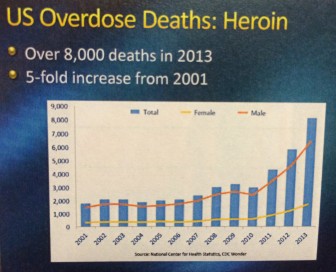
Deaths from heroin overdoses, while less than those from pain pills, have increased five fold from 2001 to 2013, Douglas said. (image from his slide presentation)
At a recent meeting of the Darien Police Commission, Police Chief Duane Lovello had this advice for any parent, particularly if the parent has doubts about whether or not his or her child is taking drugs:
“Don’t be afraid to snoop around a little bit,” Lovello said. “I mean, everybody wants to respect their child’s privacy, but at the same time, if you’re giving them a car to use and it’s for their exclusive use, you should be looking into the car once in a while to see what’s in it. You should be looking in their bedroom to see what’s going on in their bedroom.
“It’s responsible parenting, especially when you’re up against a problem that your child might not be able to deal with on their own. They need all the help they can get. If that means you’ve got to snoop a little bit, I’m all for that.”
Correction: Some statements mistakenly attributed to Robert DiRoma were made by Nick deSpoelberch.
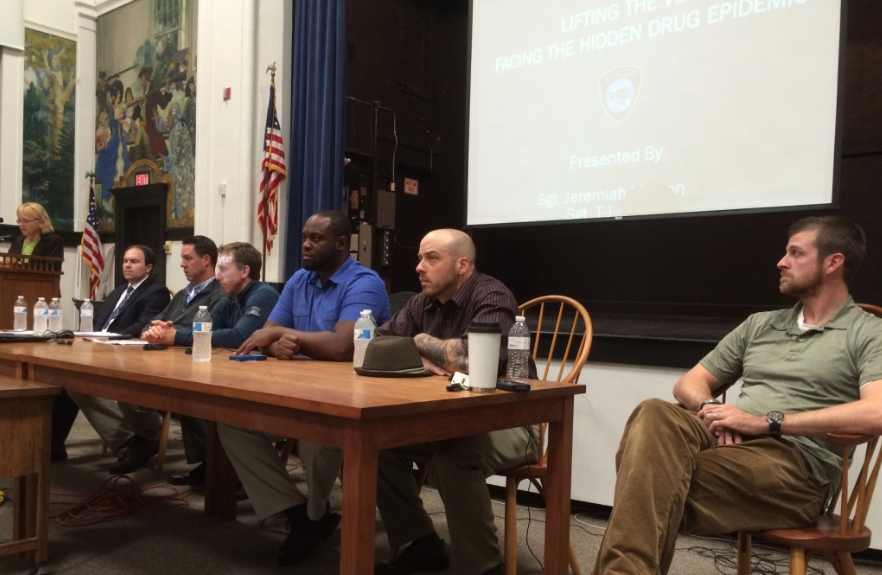

Pingback: Heroin in Darien 1: How Bad is Heroin Use in Our Town? This Bad | Darienite
“We do notice during finals, midterms, that there is a spike in medication, transactions, illicit narcotics use,” Marron said. “We hear that kids go to study at the library […] and the librarys been dubbed ‘The Candy Shop.’ […] a trading ground for prescription ‘study drugs,’ as they call them.”
?????Is there a problem at the library? Is testing driving our children to drugs??? What? Maybe we should be looking at that issue, too!
Pingback: Heroin in Darien 3: ‘I’m a Darien Resident in Recovery’ | Darienite
Pingback: Heroin in Darien 4: Heroin’s Powerful Addictiveness & How To Break Loose | Darienite
Pingback: Stevenson Discusses Opioid Painkiller Addiction at Breakfast with Legislators | Darienite
Pingback: DHS Midterms Start Soon: How the School, Darien Library Help Support Studying | Darienite